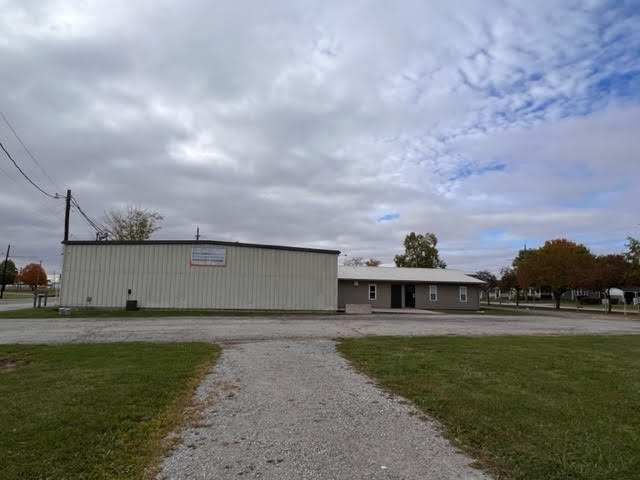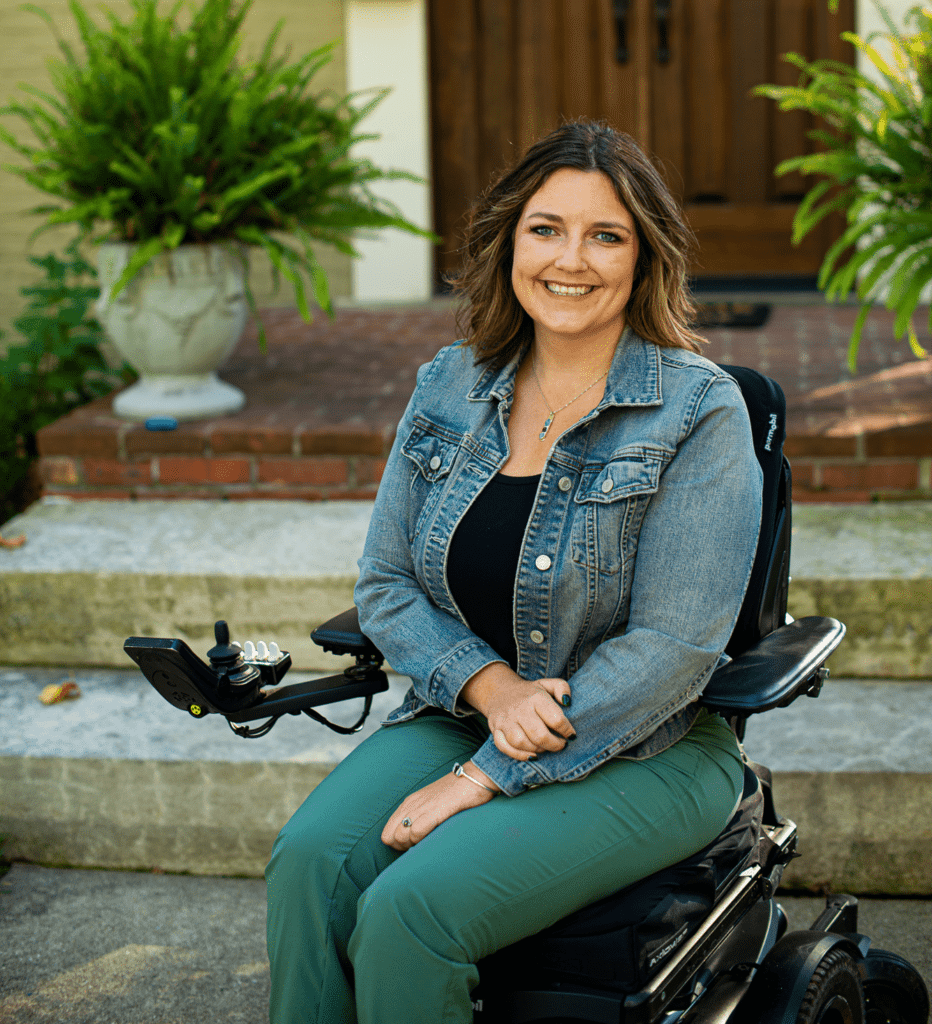
The Indiana Citizen
October 17, 2023
With four entrances, including two with wheelchair ramps and plenty of parking, the 4-H building at the Clinton County fairgrounds appeared an ideal spot for a voting site.
However, an inspection in March by Kristin Dulaney, special projects manager at Indiana Disability Rights, identified several obstacles for disabled voters. A turn built into one of the ramps was not wide enough for a wheelchair to navigate, while another ramp sloped straight into the lane of traffic that drivers would use when entering and exiting the parking lot. Other hazards included one parking area that was gravel and a set of double doors that had a very rough sill along the bottom.
A back entrance proved the most accessible. The sidewalk leads from the paved parking lot to the door, so voters can easily transverse the level surface before entering the large, open voting space.
Clinton County Clerk Stephanie Harshbarger purchased some orange cones and a handicap van accessible sign to cordon off extra space for parking for voters in wheelchairs, and her team has been crafting and laminating signs to attach to the chain-link fence to direct voters to the accessible entrance. Also, she bought a small ramp that will be placed at the doorway so no one trips over the roughly inch gap that has been caused by the sidewalk settling.
Harshbarger said learning about the barriers the site posed to disabled voters was an eye-opening experience. She is making the upgrades to improve the site so no one will be prevented from voting because he or she could not even get inside the building.
“I just thought we’ve got to make sure it’s a handicap accessible to the public,” Harshbarger said. “We’ll try to make things as best as we can.”
Dulaney surveyed the 4-H building and three other polling locations in Clinton County as part of the Hoosiers Vote project, an initiative of Indiana Disability Rights.
Hoosiers Vote is a nonpartisan effort focused on education and advocacy to ensure that disabled Hoosiers can physically get to the precinct and cast a ballot, whether they are visually or hearing impaired, or have cognitive or mobility impairments.
“We don’t endorse any particular candidates for office,” Dulaney said. “We don’t support particular ballot issues or anything. It’s just about making sure that folks have access to the ballot.”
The Americans with Disabilities Act and the Help America Vote Act of 2002 provide the right to an accessible election. Under these federal laws, polling precincts must be accommodating to the disabled by having such things as doorways wide enough for wheelchairs and voting machines at lower heights so voters can sit to cast their ballots. Also the laws give the right to vote privately and independently but still have the option of asking for assistance.
Despite the federal protections, the disabled still encounter barriers to voting. A study by Rutgers University found 14% of voters with disabilities – or 2.2 million voters – had some kind of difficulty voting in November 2022. This is more than three times the 4% of voters without disabilities who experienced difficulties in voting.
Compounding the situation is the reluctance voters can have in talking about the barriers they encountered to voting. Dulaney pointed to the Election Protection hotline (866-OUR-VOTE) that is available to offer assistance and support, but people with disabilities do not always make the call.
“Sometimes they’ll just leave the polls instead,” Dulaney said. “Or they’ll get through it, even if it wasn’t the way that they wanted it to go, and just say, ‘Well, I got my vote in, it doesn’t really matter.’”
Basement polling place
Columbus City Councilor Grace Kestler was diagnosed with muscular dystrophy as a toddler and, now 34, has spent all of adult life in a wheelchair. Currently campaigning for a second term on the city council, she went to the local community center to vote early during the May primary.
At the polling site, the wide spaces enable her to easily maneuver her wheelchair around and the lowered voting stations put the machines comfortably within her reach. Also, she knew she had the right to ask a friend or poll worker to assist her in pushing the voting machine’s buttons if she was having extra weakness in her hands.
The accessibility was vastly different to what Kestler encountered one of the first times she voted.
She went with her father to the church serving as the polling location for their precinct, but the voting was taking place in the basement. The church did not have an elevator and the stair lift stopped about two steps shy of the top of the staircase.
Recalling that day, Kestler said she considered herself “very flexible and willing to take on any challenge,” so she got on the floor and scooted down the steps to the basement while others carried her wheelchair.
“I don’t think I ever realized, ‘Wow, this is a major barrier to people,’” Kestler said. “I always reflect back to that and, really, we’ve come very far now, thankfully. The previous couple of clerks have done an amazing job; all vote locations are very accessible. But it was an eye-opening experience in the past. So, I’m glad that we’ve come from there, but it reminds me that not that long ago we had those barriers.”
Dulaney sees education as key to removing the obstacles that disabled voters face at the polling locations. Initially, Indiana Disability Rights focused on educating disabled voters about their rights, what to expect when voting and what to do if they are obstructed from casting a ballot.
The effort has since been expanded to teach election administrators. Dulaney has given presentations on voting accessibility at meetings of county clerks and, as she did with Harshbarger, offers to survey for free as many as five voting sites in a county.
Using a modified version of the ADA polling places checklist, Dulaney assesses each voting location for ease of use by the disabled as well as potential hazards that could cause injuries.
She uses a tape measure and a pressure gage to make sure doorways and hallways can accommodate a wheelchair and that doors do not need an excessive amount of force to push or pull open. Also, she looks for objects like water fountains and fire extinguishers that protrude more than 4 inches from the wall and can pose a danger of tripping for the blind.
Dulaney evaluates the slope of parking lots and ramps leading to building entrances. In addition, she makes sure at least one parking space is double wide, so voters with mobility impairments have plenty of room to exit their vehicles in their wheelchairs.
“There’s a lot of heightened scrutiny around elections rights now,” Dulaney said. “Typically, (election administrators are) just doing what they think the right thing is from moment to moment. So that’s why we really take the approach of trying to educate and make sure that we are providing the information they need for it to be a positive experience for voters with disabilities.”
‘Very positive’
Following a visit by Dulaney this past summer, Adams County Clerk Shelly Brite has been working to enhance the parking accessibility for disabled voters at every polling center in her county. She purchased handicap van accessible signs and is having them attached to poles. For the election, the signs and orange cones will be used to designate the parking spaces reserved for disabled voters.


By the numbers
Source: 2020 report by the Program for Disability Research at Rutgers University, based on the U.S. Census Bureau’s American Community Survey for 2014-2018 and census population projections for 2020- 2021.

Other tweaks and minor upgrades are being done to some locations by the building owners. Brite said some building managers were present while Dulaney evaluated the sites, asking her how they could improve compliance with the ADA and, in some cases, doing the modifications themselves.
“It was very positive,” Brite said of the reaction she received from the every one of building owners when she explained that Indiana Disability Rights would be evaluating their sites. “It was amazing to see to me. I thought there would be a little pushback but, no, they all welcomed it. They were appreciative of it.”
The fixes to accessibility barriers are usually minor and not very expensive, according to Dulaney. For example, a poll worker could be assigned to open or close a heavy door or move a trash can near a water fountain, so visually impaired individuals will hit the wastebasket with their canes and go around the protruding fixture on the wall.
For the 2023 general election, IDR is partnering with the U.S. Attorney’s Office for the Southern District of Indiana to survey the accessibility of early polling sites. This initiative is giving the organization additional personnel to not only evaluate voting locations but also raise awareness.
“Voting is the great equalizer. Everyone gets one vote,” Dulaney said. “So making sure that everybody who wants that opportunity can do so without worrying that they’re going to run into a protruding object or if there is going to be a place to park a van and drop a lift is really the goal here.”
Dwight Adams, a freelance editor and writer based in Indianapolis, edited this article. He is a former content editor, copy editor and digital producer at The Indianapolis Star and IndyStar.com, and worked as a planner for other newspapers, including the Louisville Courier Journal.
